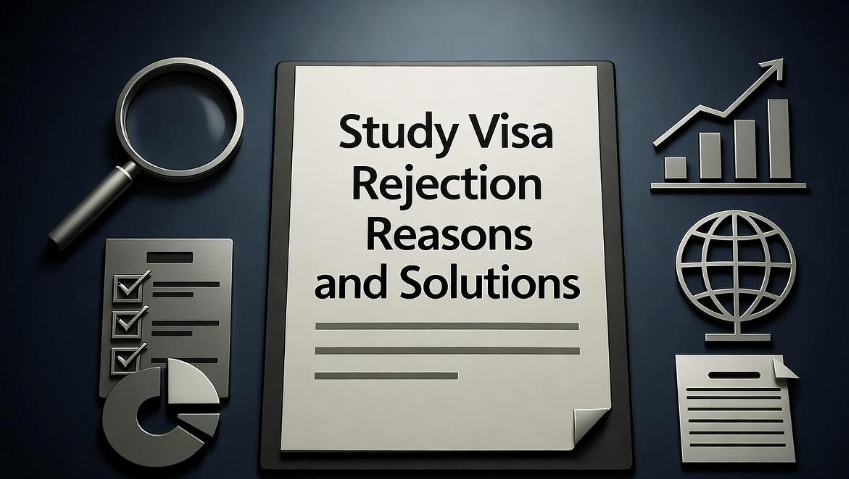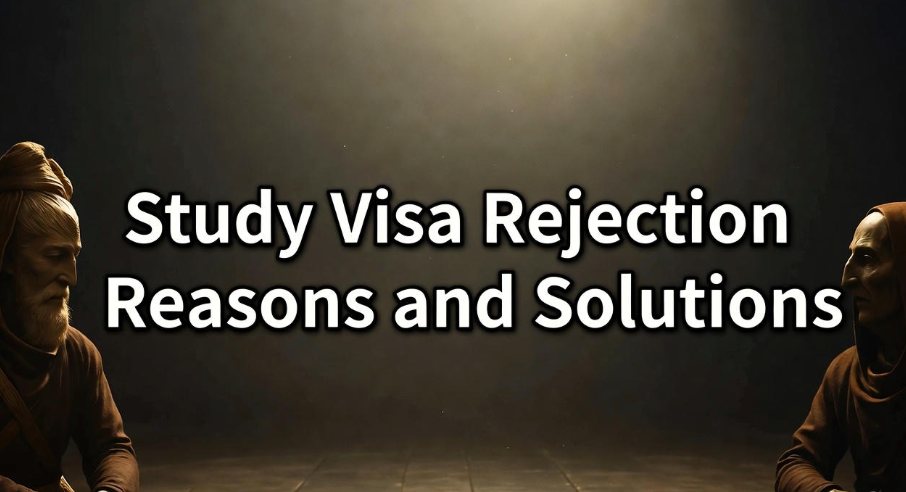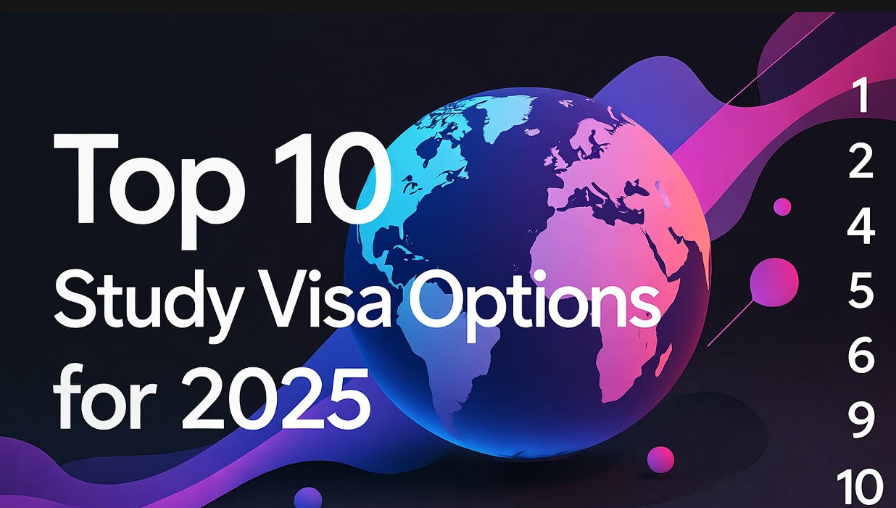Getting a study visa is one of the biggest steps toward studying abroad. But what if your dream suddenly hits a wall — a visa rejection? It can feel heartbreaking, especially when you’ve invested so much time, effort, and money.
But don’t worry — visa rejections happen more often than you think, and in many cases, they can be easily fixed with the right understanding. Let’s break it all down in a simple, friendly way so you know exactly why visas get rejected and what you can do about it.
Why Study Visas Get Rejected: The Real Reasons
Before talking about the solutions, it’s important to understand what actually goes wrong. Visa officers don’t reject applications for fun — they do it because something in your file didn’t convince them. Let’s go through the most common reasons step-by-step
1. Incomplete or Incorrect Documentation
This is the number one reason behind visa rejection worldwide.
If even one document is missing, outdated, or not properly attested, your application can be refused. The embassy expects complete, correct, and properly formatted paperwork.
✅ Solution:
Always double-check your checklist before submission.
Here’s a small sample of what you usually need:
| Document | Purpose |
|---|---|
| Passport | Identity verification |
| Offer letter | Proof of admission |
| Financial proof | Shows you can afford living and study expenses |
| Language certificate (IELTS/TOEFL) | English proficiency |
| Visa form & photos | Basic requirements |
| Statement of purpose | Explains your study goals |
Make sure all documents are up to date, consistent, and translated into English if required.
2. Weak Financial Proof
Visa officers want to know if you can really afford to study and live in their country.
If your bank statement doesn’t match your claimed funds, or if your financial sponsor seems unreliable, your application may be denied.
✅ Solution:
Maintain a clear financial trail. Use genuine bank statements, not borrowed or temporary deposits.
Here’s what helps:
-
Keep funds in your account for at least 3–6 months before applying.
-
Include tuition + living expenses in your balance.
-
Attach a sponsorship affidavit if someone else is paying.
-
Show income proofs (salary slips, business records, etc.)
Remember, they want to see financial stability, not just numbers.
3. Poor Statement of Purpose (SOP)
Your SOP tells the visa officer why you want to study abroad. If it looks copy-pasted, unclear, or unrealistic, your application may be rejected.
✅ Solution:
Write your SOP in simple, honest, and personal language. Mention:
-
Why you chose that course
-
Why that country or university
-
How the degree fits your future goals
-
Assurance that you’ll return home after studies
A genuine story always wins over fancy words.
4. Doubts About Returning Home
Many visas are denied because officers think the student might not return after graduation.
They look for “ties” with your home country — like family, job prospects, or property.
✅ Solution:
Prove strong ties back home.
Mention:
-
Family responsibilities
-
Future job plans in your country
-
Property or business ownership
-
Commitment to contribute locally after studies
Show that your intention is to study, not to migrate permanently.
5. Low Academic Performance
If your grades don’t match the course level or university standards, they might question your ability to handle studies abroad.
✅ Solution:
-
Attach transcripts showing improvement over time.
-
Include certificates of short courses or achievements.
-
Write a short note in your SOP explaining any gap or low marks (maybe due to illness or personal reasons).
Honesty works better than silence.
6. Fake or Misleading Documents ❌
Any forged paper — even a small one — leads to an instant ban. Many students fall into this trap through fake agents or “quick approval” scams.
✅ Solution:
Never use fake bank statements, IELTS certificates, or admission letters.
Embassies can verify everything digitally now. If they catch fraud, you could face a visa ban for years. Always work with genuine documents only.
7. Wrong Course Selection
If your chosen course doesn’t relate to your previous education or work experience, visa officers may think you’re not serious about academics.
✅ Solution:
Choose a course that fits logically with your background.
For example:
| Past Education | Recommended Course Abroad |
|---|---|
| Computer Science | Data Science, AI, or IT Management |
| Business | MBA, Marketing, or Finance |
| Engineering | Project Management, Robotics, or Design |
If your course is different, justify it clearly in your SOP.
8. Poor Visa Interview Performance ️
Even if all your documents are perfect, a nervous or unprepared interview can lead to rejection.
Officers want to see confidence, clarity, and genuine motivation.
✅ Solution:
Practice beforehand.
Be ready to answer questions like:
-
Why did you choose this course and university?
-
Who is sponsoring you?
-
What are your future plans after graduation?
-
Have you ever traveled abroad before?
Speak naturally — not like a memorized script. Smile and maintain good eye contact.
You may also like: Top 10 Study Visa Options for 2025
9. Incomplete Travel or Immigration History
Sometimes, not disclosing previous visa rejections or overstays leads to a new rejection.
Transparency is key.
✅ Solution:
Be 100% honest about past visa attempts.
If you were refused earlier, mention it — and explain what changed since then.
Embassies have access to global visa records, so hiding it will only make things worse.
10. Applying Through Unreliable Agents ️♂️
Many students fall for fake agents who promise “guaranteed visas.” These agents often fill wrong information or fake papers, causing rejections.
✅ Solution:
Do your own research.
If you use an agent, make sure they are officially registered with the embassy or education boards. Always review every document before signing.
What to Do After a Visa Rejection ➡️✅
If your visa gets rejected, don’t lose hope. You can reapply successfully if you fix the errors.
Here’s what to do next:
| Step | Action |
|---|---|
| Step 1 | Read the refusal letter carefully — it lists the exact reason. |
| Step 2 | Collect missing or updated documents. |
| Step 3 | Correct your SOP or financial papers. |
| Step 4 | Reapply confidently with a better file. |
| Step 5 | Avoid applying too soon — take at least 4–6 weeks to prepare. |
Most students who correct their mistakes get approved in the next attempt!
Example Case:
Ali, a student from Pakistan, applied for a Canadian study visa. His bank statement showed a sudden large deposit a week before applying — this raised a red flag. His visa was refused due to “insufficient financial evidence.”
After maintaining funds for three months and adding his father’s income proof, his second application was approved instantly.
So yes, it’s absolutely possible to turn a “No” into a “Yes.”
How to Avoid Study Visa Rejection Altogether
Let’s keep it simple — here’s a quick summary table to help you stay on track:
| Rejection Reason | Quick Fix / Solution |
|---|---|
| Missing documents | Double-check checklist |
| Weak financials | Maintain steady account for 3–6 months |
| Poor SOP | Write an honest, goal-based statement |
| Doubts about return | Show ties with your country |
| Low grades | Explain gaps & show improvement |
| Fake papers | Always use genuine documents |
| Wrong course | Pick relevant or explain your choice |
| Weak interview | Practice real questions |
| Past visa issues | Be honest about them |
| Fake agent | Work only with verified consultants |
Pro Tips to Increase Approval Chances
-
Apply early — don’t wait till the deadline.
-
Make your file organized and clean.
-
Keep two sets of photocopies of all documents.
-
Learn about your chosen country’s culture and education system (it helps in interviews).
-
Always have a backup plan (a second country or course).

Study Visa Rejection Reasons and Solutions
Common Myths About Visa Rejections (And the Truth)
| Myth | Truth |
|---|---|
| “Visa officers reject randomly.” | No, they reject based on real missing or unclear information. |
| “Reapplying after a rejection is impossible.” | False. Many students succeed on the second attempt. |
| “You need an agent for approval.” | Not true. You can apply on your own if you follow embassy rules. |
| “Low grades always lead to rejection.” | Nope — honesty and clarity can overcome average grades. |
| “Bank loans are not accepted.” | Wrong. Verified educational loans are completely acceptable. |
Final Thoughts
Visa rejections can feel like a big setback, but remember — every rejection teaches you something. The key is to understand the reason, fix it smartly, and try again. Most successful international students faced rejection at least once, but they didn’t stop.
Your dream university is still waiting for you. ✨
Take a deep breath, review your file, and reapply with confidence — this time, you’ll make it!
FAQs About Study Visa Rejection
Q1. Can I reapply immediately after a visa rejection?
Yes, but it’s better to wait at least 4–6 weeks. Use that time to fix the issues mentioned in your refusal letter.
Q2. Do I need to change my university after a rejection?
Not necessarily. If your course and documents were fine, you can reapply for the same one — just fix what was missing.
Q3. Can low IELTS scores cause rejection?
Yes, sometimes. Especially if your chosen university requires higher English proficiency. Always meet the minimum score.
Q4. Will one rejection affect my future applications?
Not if you explain it clearly in your next application. Many students get approved after their second or third attempt.
Q5. Should I hire an agent?
Only if they are certified and transparent. You can apply yourself using official embassy websites.
✨ Tip: Always check the official immigration website of your target country for the latest requirements. Don’t rely only on social media or random advice — rules change often.




